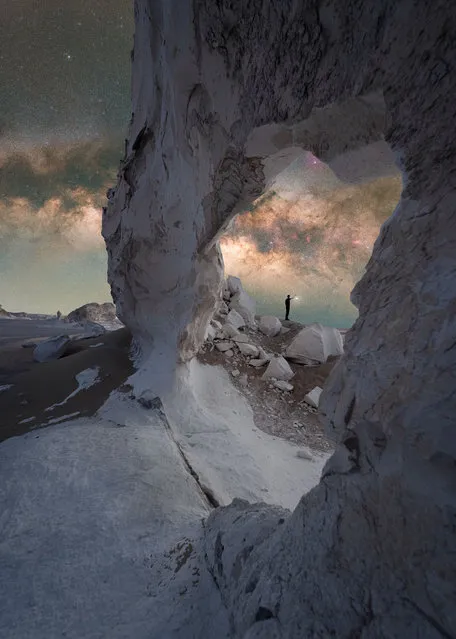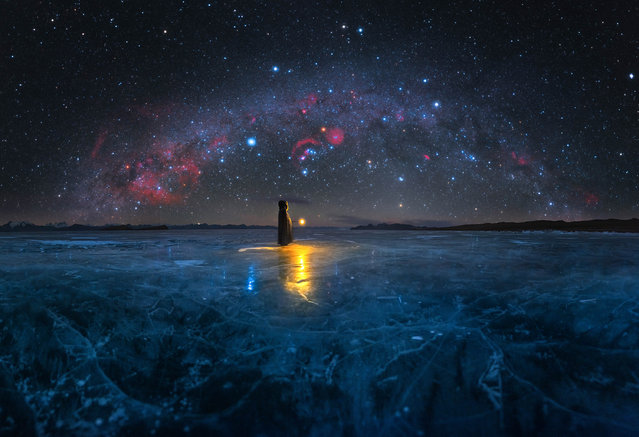
Milky Way arch in the morning hours of spring – La Palma, Canary Islands – Spain. “During the spring months, the Milky Way core starts to appear in the south-east part of the early morning sky, so it becomes possible to photograph the whole Milky Way arch at an almost 180-degree angle from north to south. I chose Pico de la Cruz, one of the summits on La Palma Island, as my main location to spend the night shooting our galaxy. Around 4am, the Milky Way was high enough in the sky that I could start shooting at 50mm and capture an arch shape without any distortion of the surrounding stars”. (Photo by Egor Goryachev/Milky Way Photographer of the Year)

Egyptian Nights – White Desert, Egypt. “This year, I went to Egypt for the first time. From Cairo, we drove about five hours west to our base camp, where we always started our explorations. The desert in Egypt is divided into the White and Black Desert. As its name suggests, the Black Desert consists of dark soil and large hills, while the White Desert is somewhat rugged but mostly consists of fine, light Saharan sand. Owing to the many sandstorms, many of these rock formations are uniquely shaped and thus offer a wide variety of compositions”. (Photo by Burak Esenbey/Milky Way Photographer of the Year)

Lightning the Milky Way – Xinjiang, China. “This photo was taken in Dahaidao Desert, the no-man’s-land in Xinjiang. Because of the often fierce wind, this area gradually eroded into separate hills that take on the unique shape of a yardang. I found this location online after lots of research and drove there in a Land Cruiser with GPS”. (Photo by Jinyi He/Milky Way Photographer of the Year)

House of Lavender – Valensole, France. “I captured this image of the Milky Way last summer in Valensole, France. The smell and atmosphere of these lavender fields are unreal, and standing there among them in the middle of the night is blissful, especially since the bees have gone to sleep and you don’t risk getting stung! Nothing is better than a warm summer night with a beautiful view of the night sky and this lonely, iconic house that sits in the middle of the lavender plateau”. (Photo by Benjamin Barakat/Milky Way Photographer of the Year)

Galactic Kiwi – Mount Taranaki, New Zealand. “Under the arch of the setting Milky Way. I had shot at this location before but felt I could do better, so I returned on an unexpected trip to give it another go. I was pleasantly surprised to find the skies had cleared up by the morning and proceeded to hike up and shoot from this spot on the Puffer. While it’s not a perfect alignment with the Milky Way, it was still my first setting arch of the year. There were even a few meteors flying around and I caught some of them on my frames”. (Photo by Evan McKay/Milky Way Photographer of the Year)

Mt. Fuji and the Milky Way over Lake Kawaguchi – Takemochi Yuki, Yamanashi Prefecture, Japan. “This location is called Fujiyama Twin Terrace. At night, you can get there by climbing some steps from the parking lot for about an hour. I captured this image on 9 April 2022, around 3am. This is the only time in spring that you can take a picture of this night view, with Mt. Fuji and the Milky Way. In winter, it becomes difficult to reach the road, since it’s covered in snow. When it gets warmer in the summer, the Milky Way rises to the west and it’s out of frame. I photographed different exposures for the different areas of the scene to balance all the light”. (Photo by Takemochi Yuki/Milky Way Photographer of the Year)

Perseid meteor shower on Mangart saddle – Julian Alps, Slovenia. “I love nature and being somewhere outside under a starry sky in serene silence. That’s when I feel free, but, at the same time, so small. What always excites me about photographing the night sky is that you never know what to expect; surprises are happening all over the sky. The weather was great at first, but as the night progressed, high clouds appeared, which, unfortunately, obscured what was happening in the sky. What surprised me while shooting is that, on this night, Mangart Saddle was full of light from all sides”. (Photo by Uroš Fink/Milky Way Photographer of the Year)

Secret – Marcin Zajac, California. “These petroglyphs were carved into a large volcanic boulder by Native Americans who inhabited this part of Eastern California thousands of years ago. By chipping away at the dark surface of the rock, they exposed the lighter rock underneath. What’s unusual about this panel is that it faces upward towards the sky, enabling some interesting compositions that include the California Sierra Nevada mountains and the night sky in the same frame”. (Photo by Marcin Zajac/Milky Way Photographer of the Year)

The salt road – San Pedro de Atacama, Chile. “When you visit the Atacama Desert, with its arid formations and starry sky, you feel like you’re on another planet. This place is the millenary salt mountain range where an unbreakable silence reigns, which is ideal for introspection and contemplating the sky. One of my favourite features of this place is the ground’s extensive layer of salt that reflects and enhances the scarce light, which comes mainly from zodiacal light and translates into less noise in the photograph”. (Photo by Daniel Zafra Portill/Milky Way Photographer of the Year)

Starlit Needle – Utah. “The badlands of Utah are brimming with stunning, unearthly landforms, hidden in the seldom seen corners of the desert. This needle-like pinnacle is one such location nestled below a set of blue shale cliffs in the Hanksville Badlands. The night sky over this region offers some of the darkest, clearest views of the stars in the entire Southwest. On clear, moonless nights, the stars shine bright enough to cast perceptible shadows on the ground, as they did on this night when I was standing below the Needle”. (Photo by Daniel Zafra Portill/Milky Way Photographer of the Year)

Winter sky over the mountains – Low Tatras, Slovakia. “Although the winter portion of the Milky Way is much weaker than the summer portion, it’s still full of beautiful features that also deserve attention. This part of the Galaxy contains many bright stars, particularly those of the Winter Hexagon asterism. Galactic arms are full of hydrogen-alpha nebulae: objects almost always invisible to the naked eye, but totally visible with an astro-modified camera. The arc of our galaxy is stretching above the Low Tatras mountains in Slovakia, where the temperatures dropped below –14C that night”. (Photo by Daniel Zafra Portill/Milky Way Photographer of the Year)

The Rocks – Motukiekie, West Coast, New Zealand. “Some of the darkest and most underrated skies are along the west coast of the South Island, a place I am fortunate to call home. A truly unique area where our southern Milky Way’s galactic core sets over the ancient sea stacks and exposed reefs. While not the composition I was hoping to shoot, due to a big swell hindering any chance of getting out onto the main reef, I’m incredibly happy with what I came away with and quite proud of the fact I was out shooting at all, as I had just had a baby 6 weeks earlier. The sleep deprivation was next level”. (Photo by Daniel Zafra Portill/Milky Way Photographer of the Year)

Ice Age – Tibet, China. “This is the Chinese version of the blue ice lake, Pumoungcuo, at an altitude of 5,070 metres (16,600 feet). This lake in Tibet freezes every winter. At night, under the low temperatures of -20C, you can listen to the sound of the ice cracking while capturing the most beautiful winter sky. The blue ice surface and dazzling Orion constellation create a fantasy landscape. I felt so happy to have the stars as my companion on this magical night”. (Photo by Daniel Zafra Portill/Milky Way Photographer of the Year)

Path to the past – Extremadura, Spain. “A natural paradise – that’s the best way to describe the Spanish region. Not only are the flora and fauna of this lesser-known region spectacular, but so are the night skies, which are full of millions of stars that seem to light up when night falls and are free of pollution and parasitic lights from large cities. Given the quality of the skies in Extremadura, there are numerous Starlight Reserves that can be enjoyed in these uninhabited lands. I took this photograph in a remote town in the southwest part of this community called Salvatierra de los Barros”. (Photo by Jose Manuel Galvan Rangel/Milky Way Photographer of the Year)

The Milky Way arching over The Pinnacles Desert – Nambung National Park, Australia. “This is a 180-degree panorama of the Milky Way as it begins to set towards the western horizon at The Pinnacles Desert, two hours north of Perth in Western Australia. The Pinnacles are such an amazing location for astrophotography. The area is littered with thousands of these limestone monoliths, which means that composition possibilities are almost endless and one of the reasons I keep coming back here year after year”. (Photo by Daniel Zafra Portill/Milky Way Photographer of the Year)
21 May 2022 05:10:00,
post received
0 comments
